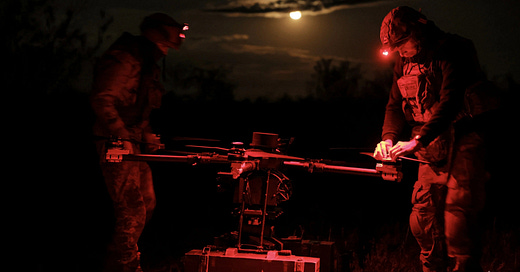How 1 Ukrainian Battalion Beat 20 Russian Battalions
Control the air with drones, sever the supply lines
Back in mid-December, Ukrainian troops from at least a dozen battalions—potentially 5,000 or more people—still occupied a 250-square-mile salient in western Russia’s Kursk Oblast. Tens of thousands Russian troops were massing to counterattack. Thousands of North Koreans reinforced them.
All eyes were on Kursk. But 220 miles to the south, around the Ukrainian fortress city of Pokrovsk, a major—and largely unheralded—battle was just beginning. One that pitted a single Ukrainian battalion and its supporting drone teams against an entire Russian division with a dozen or more battalions.
The Ukrainians won—by turning the roads leading to the battlefield into a “highway of death” for Russian truckers, to borrow analyst Andrew Perpetua’s verbiage.
Perpetua recently identified around 150 destroyed Russian trucks on a two-mile stretch of one of the several roads threading west from the Russian stronghold of Selydove toward the village of Shevchenko, a few miles south of Pokrovsk, itself the southernmost free city in a chain of free cities stretching north toward the border with Russia.
That’s a wrecked Russian truck every 70 feet.
“If you imagine, I mapped one road, right?” Perpetua said. “And it’s just because there was a video of a guy driving down the road. So every single road, every single road is like that” around Shevchenko, Perpetua added. (See video below.)
Sever the supply lines
It’s a truism in war that you can defeat a larger or deeply entrenched foe by cutting off their supply lines, starving them and depriving them of the fuel they need to keep moving and the ammunition they need to keep fighting.
Russian forces ultimately ejected the stubborn Ukrainians from Kursk in this way, by deploying the elite Rubicon drone group and its unjammable fiber-optic drones to bombard the single main road supplying the Ukrainian force in Kursk.
One Ukrainian battalion did the same thing in reverse south of Pokrovsk starting in December. Its supporting drone teams, including the famed Birds of Magyar, made it impossible for Russian supply trucks to reach the troops on the edge of battle in Shevchenko. The interdiction halted the grinding, yearlong Russian advance on Pokrovsk.
It was an incredible victory for a tiny Ukrainian force. “They were heavily outnumbered, probably like 20 to one,” Perpetua said.
Few outside observers noticed as that Ukrainian battalion made its move. But the Russian troops in Shevchenko certainly noticed. The Ukrainians “moved these drone units down to this area and that’s when they started setting up their kind of drone superiority, where they took complete control of the sky,” Perpetua recalled.
“The Russians basically couldn’t fly drones,” he added. “Their drone would take off, Ukraine would shoot it down and then attack the drone pilots—and they couldn't fly drones. The Russians were complaining of, like, a 10-to-one or worse drone ratio.”
“That drone advantage is what eventually led to this stopping the Russian attack through shutting down all of these roads,” Perpetua said. The Ukrainian drone pilots “had this policy, where they wanted to first take out the Russian drones and then—once those drones were taken out—go for the supply routes.”
Heavy hexacopter “vampire” drones fitted with night-vision gear and carrying loads of grenades or mines, many of them flown by the Birds of Magyar, inflicted the most damage on the roads to Shevchenko.
The Russians are adept at downing the 50-pound vampires with two-pound first-person-view drones that blow up on contact. But having suppressed the Russian drone teams around Shevchenko, the Ukrainian drone teams could fly their vampires with impunity.
Smaller FPV drones joined the vampires, including some fiber-optic models. After blasting every Russian supply truck in sight, the drones ranged farther south and east—and located the depots where the Russian regiments were storing the trucks and other vehicles that remained.
“The went to every vehicle depot and just blew them all up so they had, like, no tanks, no BMPs,” Perpetua mused. “They took out all their MRAP [armored trucks] and then they just shut down every single road, so they starved out the Russians.”
To reinforce Shevchenko, the Russians had to walk … for miles. “Their engineers were saying, ‘We have to build a minefield, but we can’t bring any trucks up. So everyone has to carry two mines,’” Perpetua laughed. “So there’s these videos of infantry marching up and, you know, they’re being told that you have to march [12 miles]. You have to bring all of the food and ammo to last two weeks and you have to carry two landmines.”
Sensing weakness, that sole Ukrainian battalion attacked—temporarily kicking the Russian division out of Shevchenko. “The Russians in that area were saying if Ukraine continued their assault forward, if they continued those tactics [and] if the rest of the [Ukrainian] brigade joined in … the Russians were probably going to have to pull back” as far as 12 miles, Perpetua said.
In fact, the whole brigade didn’t join in, perhaps owing to a shortage of infantry, and the Ukrainian battalion eventually pulled back. Shevchenko is now in the uncontrolled gray zone between Russian and Ukrainian positions south of Pokrovsk.
The city is still in peril, but not from the south. Instead, it’s in danger of being encircled by Russian regiments attacking from the northeast. To stop that attack, the Ukrainians could repeat that battalion’s tactics in Shevchenko.
“You shut down all the roads, take a bite out of the Russians,” Perpetua explained, “move forward a few [miles] with your multiple brigades, set up camp, you know, set up a defensive line and then move forward with your drones, cut off the supply lines again—and just keep doing that.”
Read more:
Ukrainian Tanks Attack in Sumy—3 Russian Regiments Cut Off?
Shortly after drone-harried Ukrainian forces retreated from western Russia’s Kursk Oblast in mid-March, bringing to an abrupt end a controversial seven-month Ukrainian incursion, Russian forces counterattacked—and crossed into Sumy Oblast in northern Ukraine.






